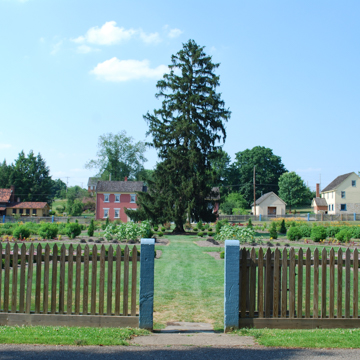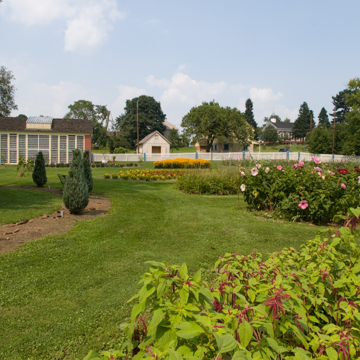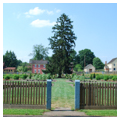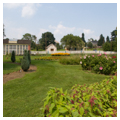The Society of Separatists of Zoar thrived in the village of Zoar 1817 to 1898. This religious utopian society sought to create a comprehensive environment that fostered a communal lifestyle while preserving their Germanic cultural traditions, in building and in land use.
The 2.5-acre Zoar Garden, also called the Biblical garden, is the centerpiece of the village. The landscape’s geometric design was intended as an illustration of the Separatists’ religious views. The garden’s focal point is a large Norway spruce (likely not the original) representing the tree of life and salvation. The rest of the planting is arranged around the spruce in a symmetrical pattern including twelve trees representing the apostles. Twelve radiating paths indicated righteousness; the gridded paths represented routes to temptation. The overlaid pathway systems divide the garden into multiple beds planted with a variety of flowers and shrubs. The Zoar Garden was in existence by 1829 and celebrated during the nineteenth century for its high level of cultivation, especially of seasonal fruits and vegetables, and for its tidy appearance. The garden also contributed to Zoar’s economy: as early as 1836, its plants and bulbs were sold throughout the Midwest. Geraniums, roses, and hydrangeas were shipped to Cleveland on the Society’s canal boat.
In 1850, a Gardener’s House and Greenhouse (House No. 11) was constructed on the northern edge of the garden. This is a 2-story brick residence on a sandstone foundation with an attached brick greenhouse.
The symbolic and meditative garden was popular with visitors throughout Zoar’s history, but after the Zoarites disbanded in 1898, the garden was soon overgrown. By the 1920s, the Zoar Hotel had placed tennis courts on the garden site. By then the village was also threatened with wholesale demolition as part of a flood control plan for the Tuscarawas River. These threats spurred village residents to action and restoration efforts for the garden commenced in 1929. In 1937, the Gardener’s House was included in the Historic American Building Survey’s documentation of the village. In 1941, the Ohio State Archaeological and Historical Society acquired the building, along with the Number One House and the garden itself, in order to insure their preservation. In 1970, the Gardener’s House was restored to its 1898 appearance; restoration work included re-installing windows in closed-up openings and placing a new skylight in the greenhouse.
The Zoar Biblical Garden is part of the Zoar Historic District, designated a National Historic Landmark in 2016.
References
Avdakov, Steven, Debbie Griffin, and Nathalie Wright, “Zoar Historic District,” Tuscarawas County, Ohio. National Historic Landmark Nomination, 2016. National Park Service, U.S. Department of the Interior, Washington, D.C.
Fernandez, Kathleen M. A Singular People: Images of Zoar. Kent, OH: Kent State University Press, 2003.
Hinds, William Alfred. American Communities. Rev. ed. Chicago: Charles H. Kerr and Company, 1902.
Morhart, Hilda Dischinger. The Zoar Story. Dover, OH: Seibert Printing Company, 1967.
Nixon, Edgar Burkhardt. “The Society of Separatists of Zoar.” Ph.D. dissertation, The Ohio State University, 1933.
Nordhoff, Charles. Communistic Societies of the United States. New York: Harper and Brothers, 1875.
Robison, Elwin C. “Heavenly Aspirations and Earthly Realities: Four Northeast Ohio Religious Utopias.” Timeline17, no. 6 (November/December) 2000: 2-25.




